NCERT Exemplar Solutions: Winds, Storms & Cyclones - Class 7 PDF Download
| Table of contents |

|
| Multiple Choice Questions |

|
| Very Short Answer Questions |

|
| Short Answer Questions |

|
| Long Answer Questions |

|
Multiple Choice Questions
Q.1. A fire alarm usually detects smoke in case of fire. Where should such an alarm be placed in a room?
(a) Near the door
(b) On the floor
(c) On any wall
(d) On the ceiling
Ans: d
Explanation:
In case of fire, the air above the fire gets heated hence fire alarms are set on the ceiling
Q.2. Four schematic diagrams are shown in Figure 8.1 to depict the direction of the sea breeze. Which of them gives the correct direction?
(a)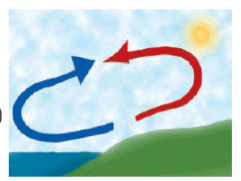
(b)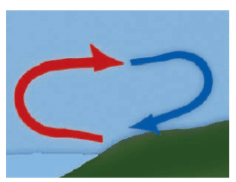
(c)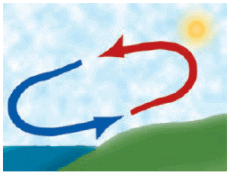
(d)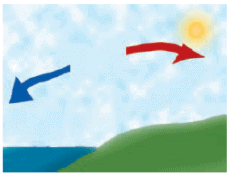
Soln: c
Explanation:
During summer land becomes heated, air over land rises. This makes the cooler air blow from the sea towards the land. This air is called as the sea breeze.
Q.3. Figure shows a child blowing air with a straw near the opening of another straw which has its other end in a soft drink bottle. It was observed that the level of the soft drink in the straw rises up as soon as air is blown over its open end. Which one of the following best explains the reason for the rise in the level of the drink?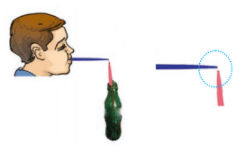
(a) The blowing of air decreases pressure over the opening of the straw.
(b) The straw of the soft drink bottle collapses when air is blown over its open end.
(c) The blowing of air warms up the air inside the straw.
(d) The blowing of air increases the pressure on the surface of the soft drink in the bottle.
Ans: a
Explanation:
Decreased pressure over the opening of the straw makes the level of soft drinks rise.
Q.4. Following are precautions one must take in case a storm is accompanied by lightning.
(i) Do not take shelter under a tree.
(ii) Do not take shelter under an umbrella with a metallic end.
(iii) Do not take shelter in open garages, storage sheds, etc.
(iv) Do not take shelter in a bus in the open.
Which one of these is not correct?
(a) (i)
(b) (ii)
(c) (iii)
(d) (iv)
Ans: d
Q.5. Which of the following place is most likely to be affected by a cyclone?
(a) Mumbai
(b) Puri
(c) Goa
(d) Porbandar
Ans: b
Explanation:
Because Puri lies near the coastal area.
Q.6. A curtain is hanging at the entrance of a room. A long corridor runs at right angles to the door, that is parallel to the curtain. If a strong wind blows along the corridor, the curtain will
(a) get pushed inside the room.
(b) get pushed outside the room.
(c) get collected towards one end/swirled.
(d) remain unaffected.
Ans: b
Explanation:
If a strong wind blows along the corridor, then the air pressure increases and the curtain gets pushed outside the room.
Very Short Answer Questions
Q.7. Why is Chandigarh unlikely to be affected by a cyclone?
Ans: Chandigarh is very far from sea hence it is unlikely to be affected by a cyclone.
Q.8. Name the ocean which is mainly responsible to bring rain-bearing monsoon winds to Kerala coast in June every year?
Ans: Indian Ocean
Q.9. Fill in the blanks.
(i) Air around us exerts __________ .
(ii) The moving air is called _________ .
(iii) The main cause of wind movement is uneven ___________ on the earth.
(iv) High speed wind can cause cyclone in regions of ___________ pressure.
Ans:
(i) The air around us exerts Pressure.
(ii) The moving air is called Wind.
(iii) The main cause of wind movement is uneven heating on the earth.
(iv) High-speed wind can cause cyclone in regions of low pressure.
Q.10. State whether the following statements are True or False:
(i) If wind flows from land to the ocean, then it is daytime.
(ii) A very high-pressure system, with very high-speed wind surrounding it forms a cyclone.
(iii) The coastline of India is not vulnerable to cyclones.
(iv) Warm air is lighter than cool air.
Ans:
(i) False- if the wind blows from land to the ocean, then it is night time because, at night, the water cools down more slowly than the land. So, the cool wind from the land moves towards the ocean.
(ii) False – a very low-pressure system, with very high-speed winds revolving around it, forms a cyclone.
(iii) False- the whole coastline of India is vulnerable to cyclones, particularly the east coast.
(iv) True
Q.11. To expel hot air out of the kitchen, ‘A’ has an exhaust fan fitted on the window of her kitchen and ‘B’ has a similar exhaust fan fitted on the wall near the ceiling of her kitchen. Which of the exhaust fan will expel the hot air more effectively? Explain why?
Ans: Exhaust fan of B will expel the hot air effectively as air rises up and her fan is at a greater height than A’s.
Q.12. Why is it advisable not to shut all the doors and windows during a storm?
Ans: In order to avoid the roof from getting blown away due to the low pressure created by heavy wind.
Q.13. A flat in Mumbai with a balcony facing the sea has some clothes hung on a clothesline in the balcony. Towards which direction the clothes will be blown in the afternoon? Explain.
Ans: Because the sea breeze blowing towards the land clothes will be blown towards the house.
Q.14. Figure shows a diagrammatic representation of trees in the afternoon along a sea coast. State on which side is the sea; A or B? Give reasons for your choice.
Ans: Sea is on the side of B as the wind is blowing from the sea to the land.
Q.15. A flag mounted on a flag post near the sea coast flutters in the direction of sea. At what time of the day does this happen – at midnight or in the afternoon?
Ans: Midnight, because of a land breeze.
Short Answer Questions
Q.1. Match Column I with Column II. There can be more than one match.
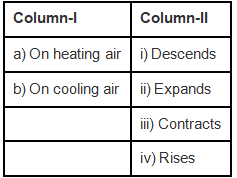
Ans:
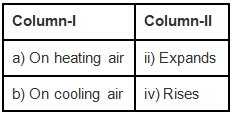
Q.2. Paheli kept an empty bottle made of plastic inside a refrigerator. After few hours, when she opened the refrigerator she found the bottle had collapsed. Explain the possible reason.
Ans: The air inside the bottle contracts due to low temperature hence the bottle collapses due to the outside pressure.
Q.3. When strong/high-speed wind blows, an umbrella held upright at times gets upturned. Explain the reason.
Ans: Umbrella upturns because of the high-speed water passing through umbrella creates low pressure.
Q.4. Suggest some precautions to be taken to prevent the roof of a tin sheet from flying away during a fierce wind storm
Ans:
(i) Put heavy stones on it.
(ii) Screw it tight.
Long Answer Questions
Q.1. Describe an activity to demonstrate that warm air is lighter than cool air.
Ans: Take two paper bags or empty paper cups of the same size. Hang the two bags in the inverted position on the two ends of a metal or wooden stick. Tie a piece of thread in the middle of the stick. Hold the stick by the thread (Fig) as in a balance. Put a burning candle below one of the bags as shown in the figure. As the warm air rises up, it pushes the bag above the candle.
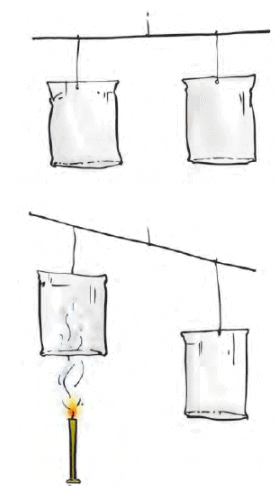
Q.2. The picture in Figure shows tree line along the sea coast on an island near the equator. As shown, the tree tops are permanently bent in one direction. Are the trees bent towards the sea or away from it? Explain.

Ans: In the coastal regions of an island near the equator, heating and cooling of air are a regular phenomenon. During the daytime, the land gets heated up quickly compared to the water in the sea. The air above the land gets heated and rises up and is replaced by the cool air from the sea giving rise to the sea breeze. This sea breeze makes the trees to bend towards the land.
Q.3. Identify the names of six natural phenomena from the following word diagram given as Figure.
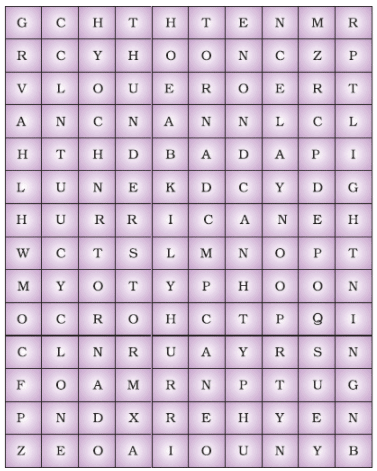
Ans: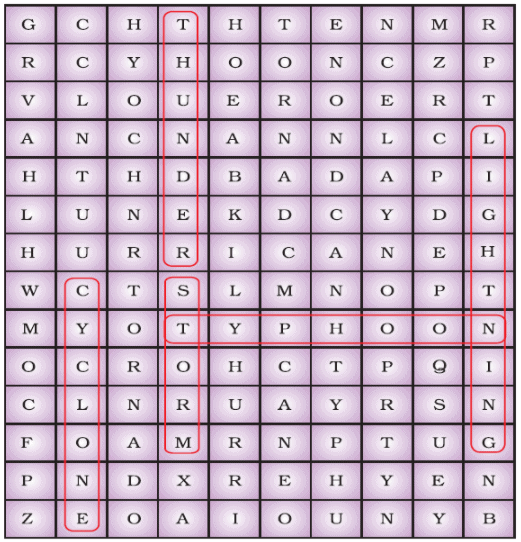
FAQs on NCERT Exemplar Solutions: Winds, Storms & Cyclones - Class 7
| 1. What are the different types of winds? |  |
| 2. How are cyclones formed? |  |
| 3. What is the difference between a tornado and a cyclone? |  |
| 4. How are storms formed? |  |
| 5. What is the impact of storms and cyclones on human life and the environment? |  |














